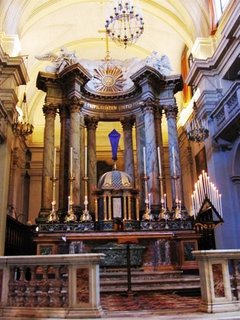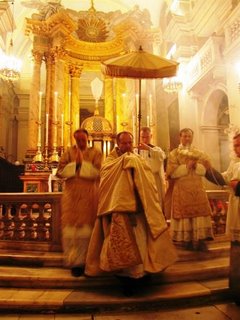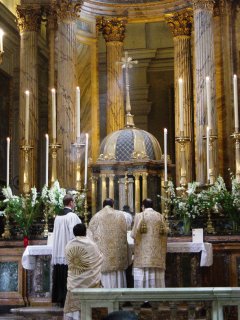The Guelf
The Latin Mass in Melbourne, Australia, the Latin Mass / Traditional Latin Mass / Tridentine Mass / Classical Roman Rite, the Catholic Church, Melbourne and Australian society: Idle musings
Tuesday, March 13, 2007
Thursday, March 08, 2007
Monday, January 08, 2007
Monday, November 06, 2006
Wednesday, November 01, 2006
The Eucharist: the source and summit of the whole of Christian life

Photo courtesy The Indolent Server and CathCon.
From Redemptionis Sacramentum:
[6.] For abuses “contribute to the obscuring of the Catholic faith and doctrine concerning this wonderful sacrament”.[14] Thus, they also hinder the faithful from “re-living in a certain way the experience of the two disciples of Emmaus: ‘and their eyes were opened, and they recognized him’”.[15] For in the presence of God’s power and divinity[16] and the splendour of his goodness, made manifest especially in the Sacrament of the Eucharist, it is fitting that all the faithful should have and put into practice that power of acknowledging God’s majesty that they have received through the saving Passion of the Only-Begotten Son.[17]
[11.] The Mystery of the Eucharist “is too great for anyone to permit himself to treat it according to his own whim, so that its sacredness and its universal ordering would be obscured”.[27]
[27.] As early as the year 1970, the Apostolic See announced the cessation of all experimentation as regards the celebration of Holy Mass[62] and reiterated the same in 1988.[63]
[31.] In keeping with the solemn promises that they have made in the rite of Sacred Ordination and renewed each year in the Mass of the Chrism, let Priests celebrate “devoutly and faithfully the mysteries of Christ for the praise of God and the sanctification of the Christian people, according to the tradition of the Church, especially in the Eucharistic Sacrifice and in the Sacrament of Reconciliation”.[71] They ought not to detract from the profound meaning of their own ministry by corrupting the liturgical celebration either through alteration or omission, or through arbitrary additions.[72]
[33.] Finally, all “Priests should go to the trouble of properly cultivating their liturgical knowledge and ability, so that through their liturgical ministry, God the Father, Son and Holy Spirit will be praised in an ever more excellent manner by the Christian communities entrusted to them”.[75] Above all, let them be filled with that wonder and amazement that the Paschal Mystery, in being celebrated, instills in the hearts of the faithful.[76]
[38.] The constant teaching of the Church on the nature of the Eucharist not only as a meal, but also and pre-eminently as a Sacrifice, is therefore rightly understood to be one of the principal keys to the full participation of all the faithful in so great a Sacrament.[97] For when “stripped of its sacrificial meaning, the mystery is understood as if its meaning and importance were simply that of a fraternal banquet”.[98]
[40.] Nevertheless, from the fact that the liturgical celebration obviously entails activity, it does not follow that everyone must necessarily have something concrete to do beyond the actions and gestures, as if a certain specific liturgical ministry must necessarily be given to the individuals to be carried out by them. Instead, catechetical instruction should strive diligently to correct those widespread superficial notions and practices often seen in recent years in this regard, and ever to instill anew in all of Christ’s faithful that sense of deep wonder before the greatness of the mystery of faith that is the Eucharist, in whose celebration the Church is forever passing from what is obsolete into newness of life: “in novitatem a vetustate”.[101] For in the celebration of the Eucharist, as in the whole Christian life which draws its power from it and leads toward it, the Church, after the manner of Saint Thomas the Apostle, prostrates herself in adoration before the Lord who was crucified, suffered and died, was buried and arose, and perpetually exclaims to him who is clothed in the fullness of his divine splendour: “My Lord and my God!”[102]
[42.] It must be acknowledged that the Church has not come together by human volition; rather, she has been called together by God in the Holy Spirit, and she responds through faith to his free calling (thus the word ekklesia is related to klesis, or “calling”).[106] Nor is the Eucharistic Sacrifice to be considered a “concelebration”, in the univocal sense, of the Priest along with the people who are present.[107] On the contrary, the Eucharist celebrated by the Priests “is a gift which radically transcends the power of the community. . . . The community that gathers for the celebration of the Eucharist absolutely requires an ordained Priest, who presides over it so that it may truly be a eucharistic convocation. On the other hand, the community is by itself incapable of providing an ordained minister”.[108] There is pressing need of a concerted will to avoid all ambiguity in this matter and to remedy the difficulties of recent years. Accordingly, terms such as “celebrating community” or “celebrating assembly” (in other languages “asamblea celebrante”, “assemblée célébrante”, assemblea celebrante”) and similar terms should not be used injudiciously.
[44.] Apart from the duly instituted ministries of acolyte and lector,[111] the most important of these ministries are those of acolyte[112] and lector[113] by temporary deputation. In addition to these are the other functions that are described in the Roman Missal,[114] as well as the functions of preparing the hosts, washing the liturgical linens, and the like. All, “whether ordained ministers or lay faithful, in exercising their own office or ministry should do exclusively and fully that which pertains to them”.[115] In the liturgical celebration itself as well as in its preparation, they should do what is necessary so that the Church’s Liturgy will be carried out worthily and appropriately.
[45.] To be avoided is the danger of obscuring the complementary relationship between the action of clerics and that of laypersons, in such a way that the ministry of laypersons undergoes what might be called a certain “clericalization”, while the sacred ministers inappropriately assume those things that are proper to the life and activity of the lay faithful.[116]
[46.] The lay Christian faithful called to give assistance at liturgical celebrations should be well instructed and must be those whose Christian life, morals and fidelity to the Church’s Magisterium recommend them. It is fitting that such a one should have received a liturgical formation in accordance with his or her age, condition, state of life, and religious culture.[117] No one should be selected whose designation could cause consternation for the faithful.[118]
[57.] It is the right of the community of Christ’s faithful that especially in the Sunday celebration there should customarily be true and suitable sacred music, and that there should always be an altar, vestments and sacred linens that are dignified, proper, and clean, in accordance with the norms.
[93.] The Communion-plate for the Communion of the faithful should be retained, so as to avoid the danger of the sacred host or some fragment of it falling.[180]
[94.] It is not licit for the faithful “to take . . . by themselves . . . and, still less, to hand . . . from one to another” the sacred host or the sacred chalice.[181] Moreover, in this regard, the abuse is to be set aside whereby spouses administer Holy Communion to each other at a Nuptial Mass.
[108.] “The celebration of the Eucharist is to be carried out in a sacred place, unless in a particular case necessity requires otherwise. In this case the celebration must be in a decent place.”[197] The diocesan Bishop shall be the judge for his diocese concerning this necessity, on a case-by-case basis.
[109.] It is never lawful for a Priest to celebrate in a temple or sacred place of any non-Christian religion.
[117.] Sacred vessels for containing the Body and Blood of the Lord must be made in strict conformity with the norms of tradition and of the liturgical books.[205]The Bishops’ Conferences have the faculty to decide whether it is appropriate, once their decisions have been given the recognitio by the Apostolic See, for sacred vessels to be made of other solid materials as well. It is strictly required, however, that such materials be truly noble in the common estimation within a given region,[206]so that honour will be given to the Lord by their use, and all risk of diminishing the doctrine of the Real Presence of Christ in the Eucharistic species in the eyes of the faithful will be avoided. Reprobated, therefore, is any practice of using for the celebration of Mass common vessels, or others lacking in quality, or devoid of all artistic merit or which are mere containers, as also other vessels made from glass, earthenware, clay, or other materials that break easily. This norm is to be applied even as regards metals and other materials that easily rust or deteriorate.[207]
[121.] “The purpose of a variety of colour of the sacred vestments is to give effective expression even outwardly to the specific character of the mysteries of faith being celebrated and to a sense of Christian life’s passage through the course of the liturgical year”.[210] On the other hand, the variety “of offices in the celebration of the Eucharist is shown outwardly by the diversity of sacred vestments. In fact, these “sacred vestments should also contribute to the beauty of the sacred action itself”.[211]
[122.] “The alb” is “to be tied at the waist with a cincture unless it is made so as to fit even without a cincture. Before the alb is put on, if it does not completely cover the ordinary clothing at the neck, an amice should be put on”.[212]
[123.] “The vestment proper to the Priest celebrant at Mass, and in other sacred actions directly connected with Mass unless otherwise indicated, is the chasuble, worn over the alb and stole.”[213] Likewise the Priest, in putting on the chasuble according to the rubrics, is not to omit the stole. All Ordinaries should be vigilant in order that all usage to the contrary be eradicated.
[124.] A faculty is given in the Roman Missal for the Priest concelebrants at Mass other than the principal concelebrant (who should always put on a chasuble of the prescribed colour), for a just reason such as a large number of concelebrants or a lack of vestments, to omit “the chasuble, using the stole over the alb”.[214] Where a need of this kind can be foreseen, however, provision should be made for it insofar as possible. Out of necessity the concelebrants other than the principal celebrant may even put on white chasubles. For the rest, the norms of the liturgical books are to be observed.
[125.] The proper vestment of the Deacon is the dalmatic, to be worn over an alb and stole. In order that the beautiful tradition of the Church may be preserved, it is praiseworthy to refrain from exercising the option of omitting the dalmatic.[215]
[126.] The abuse is reprobated whereby the sacred ministers celebrate Holy Mass or other rites without sacred vestments or with only a stole over the monastic cowl or the common habit of religious or ordinary clothes, contrary to the prescriptions of the liturgical books, even when there is only one minister participating.[216] In order that such abuses be corrected as quickly as possible, Ordinaries should take care that in all churches and oratories subject to their jurisdiction there is present an adequate supply of liturgical vestments made in accordance with the norms.
[127.] A special faculty is given in the liturgical books for using sacred vestments that are festive or more noble on more solemn occasions, even if they are not of the colour of the day.[217] However, this faculty, which is specifically intended in reference to vestments made many years ago, with a view to preserving the Church’s patrimony, is improperly extended to innovations by which forms and colours are adopted according to the inclination of private individuals, with disregard for traditional practice, while the real sense of this norm is lost to the detriment of the tradition. On the occasion of a feastday, sacred vestments of a gold or silver colour can be substituted as appropriate for others of various colours, but not for purple or black.
[128.] Holy Mass and other liturgical celebrations, which are acts of Christ and of the people of God hierarchically constituted, are ordered in such a way that the sacred ministers and the lay faithful manifestly take part in them each according to his own condition. It is preferable therefore that “Priests who are present at a Eucharistic Celebration, unless excused for a good reason, should as a rule exercise the office proper to their Order and thus take part as concelebrants, wearing the sacred vestments. Otherwise, they wear their proper choir dress or a surplice over a cassock.”[218] It is not fitting, except in rare and exceptional cases and with reasonable cause, for them to participate at Mass, as regards to externals, in the manner of the lay faithful.
Tuesday, October 31, 2006
A press conference?
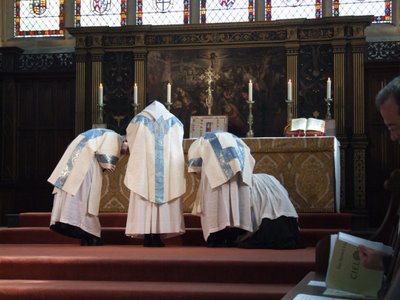
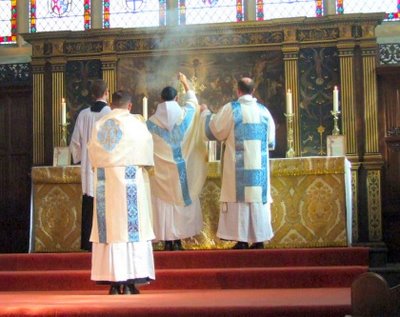

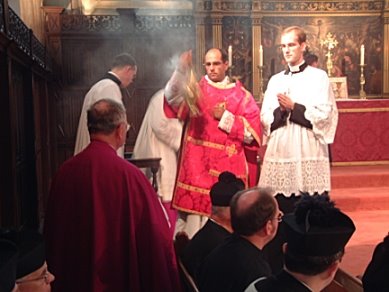

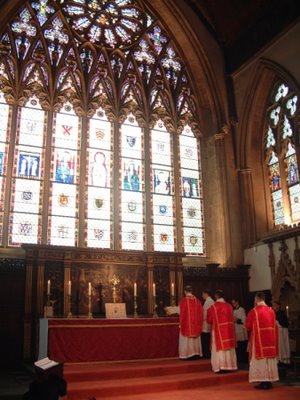

Is this the most solemn moment in the Mass or a press conference?
Look at the vestments? Is that a chasuable I see there??
Or shall we compare: From Merton College, Oxford, the CIEL conference, courtesy of our friends at the New Liturgical Movement:
Which makes you believe what both stand for: that the bread and wine become the Body, Blood, Soul and Divinity of Christ?
Monday, October 30, 2006
Communique of Vox Clara meeting 27 October 2006
From our friends at Whispers in the Loggia:
VOX CLARA COMMITTEEPRESS RELEASE
October 27, 2006
The Vox Clara Committee met for the tenth time from October 23-26, 2006 in the offices of the Congregation for Divine Worship and the Discipline of the Sacraments in Rome.Since its establishment by the Congregation on July 19, 2001, this Committee of senior Bishops from Episcopal Conferences throughout the English-speaking world has provided advice to the Holy See concerning English-language liturgical books, ever seeking to strengthen effective cooperation with the Conferences of Bishops in this regard. The terms of the members and advisors were recently extended by the Congregation.The Vox Clara Committee is chaired by Cardinal George Pell, Sydney (Australia). The participants in the meeting were Archbishop Oscar Lipscomb, Mobile (USA), who serves as First Vice-Chairman; Archbishop Alfred Hughes, New Orleans (USA); Archbishop Terrence Prendergast, S.J., Halifax (Canada); Archbishop Peter Kwasi Sarpong, Kumasi (Ghana); Archbishop Kelvin Felix, Castries (Saint Lucia), and Bishop Philip Boyce, O.C.D., Raphoe (Ireland). Bishop David McGough was present as a pro-tempore representative of Cardinal Cormac Murphy-O’Connor, Westminster (England), who serves as Secretary. Other members of the Committee, though not present at the meeting, are: Cardinal Francis George, O.M.I., Chicago (USA); Cardinal Justin Rigali, Philadelphia (USA), who serves as Treasurer; Archbishop Oswald Gracias, Mumbai (India), who serves as Second Vice-Chairman.The members were assisted in their work by the following Advisors: Monsignor Gerard McKay (Rome), Abbot Cuthbert Johnson, O.S.B. (England), Father Jeremy Driscoll, O.S.B. (USA), Father Dennis McManus (USA), and Monsignor James P. Moroney (USA). Secretarial support was provided by Father Robert Keighron (USA). The Committee continues to receive valuable assistance and support from the officials of the Congregation.The preponderance of the work of the Committee was devoted to a review of the most recent ICEL Green Book translation of the Common of the Saints. The improvement that had been previously noted in the translations was manifested in many texts of a truly outstanding quality. At the same time, the Committee provided the Congregation with extensive commentary on certain problems and noted the importance of continuing to rely upon the principles of the instruction Liturgiam Authenticam and its particular application in the Ratio Translationis [the guidelines for liturgical translations]. The Committee appreciated that ICEL is maintaining its increasingly ambitious schedule for completion of translations of the Missale Romanum, editio typica tertia.On the second day of the meeting, the members and advisors met with Cardinal Francis Arinze, Prefect of the Congregation for Divine Worship and the Discipline of the Sacraments. At the conclusion of his remarks, Cardinal Pell thanked Cardinal Arinze for his “regular and constant support” of the work of Vox Clara.The Committee was also asked to conduct a final review of the Ratio Translationis for the English Language, which serves as a reliable application of the principles of the instruction Liturgiam authenticam to English-language translations of Roman liturgical texts (cf. Liturgiam authenticam, no. 9). Between June, 2005 and August, 2006, the Congregation conducted a consultation on a provisional text of the Ratio, which will be published by the Congregation in a definitive form in the near future.The members of the Vox Clara Committee noted their satisfaction with the work of translation as the completion of the Roman Missal draws ever closer. The careful and patient collaboration of the Conferences of Bishops and the Holy See in the review of the translations produced thus far by the International Commission on English in the Liturgy remains the key to the successful completion of this project. The members of the Vox Clara Committee join with the ICEL Commissioners and the Bishop members of the English-language Conferences of Bishops in working toward a translation of the Missale Romanum which is “characterized by a kind of language which is easily understandable, yet which at the same time preserves these texts’ dignity, beauty, and doctrinal precision.” (Liturgiam Authenticam, no. 25)The Committee will meet again in December, 2006 and has planned for four meetings in the course of the coming year.







